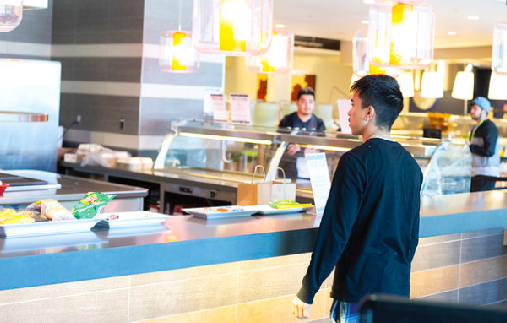When it comes to purchasing a meal plan as a college student, it’s important to ensure students that they will be provided with a plan that they will enjoy. According to Sonoma State’s website, students’ cost of attendance for food and housing ranges from $6,000 a year to $16,000 a year. With that being said, it is of students’ interest to know what steps are taken to provide the best experience when it comes to eating on campus.
Between Sept. 15 and Sept. 29, Sonoma State University’s Culinary Services will be asking students who live on and off-campus to sign up to participate in the new Food Diary Project, which its goal is to improve the food services offered to its students. Those who are chosen will receive 75 dollars in Wolfbucks as an appreciation of involvement.
Out of those who submit an interest form, Culinary Services will choose ten students, half living on campus and a half living on campus, to participate in the Food Diary Project. Students who want to participate in The Food Diary Project can fill out an interest form on the Seawolf Living website.
The chosen 10 members will then keep Culinary Services informed, from Oct. 12 through Oct. 25, what they eat and when, where they shop and when, where they eat, how often they cook at home, how long it takes for a meal or snack prep, and the cost for snacks and meals with receipts.
Director of Culinary Services, Nancy Keller, says that what inspired The Food Diary Project was her curiosity on how to measure student eating patterns and that the project, “… was created to gain insight into current students eating, cooking, shopping, and spending habits.”
Keller explained that because the Culinary Services’ dining venues are closed due to the pandemic, local health orders, and a limited number of students on campus, that the team, “…saw this time as an opportunity to get real data and information from current students.”
Casey Kelly, the Marketing Manager for Entrepreneurial Activities at Sonoma State, said the marketing team is providing support for Culinary Services by offering their expertise on how to reach students and help analyze their data once the project is completed.
“Culinary Services had a need to get students involved in this project, and we have the means to reach students through Seawolf Living, social media, emails, and our website” said Kelly.
After receiving the student’s “food diaries,” Culinary Services will be sharing the collected data from the ten selected students and present it to the Culinary Services Advisory Board and Sonoma State Enterprises (SSE) Board, where there will be recommendations made for future plans for dining venues, vending, and operations.
Culinary Services want to enhance student life and student success by providing a variety of quality and nutritional foods while making an impact on the community that they serve. The information that they gather is valuable for getting a better understanding of their student community.
“This information is valuable to get a better idea of patterns from our current student community” said Keller.
Keller explained why this project should be considered important to the students of Sonoma State, saying that “… Participating in the Food Diary project is an opportunity for students to greatly impact the future of Culinary Services offerings and operations.”
Participating in the Food Diary Project will not only provide insight about the student population at Sonoma State, allowing Culinary Services to better understand the needs of Seawolves when it comes to food services, but it will also benefit the future of Sonoma State and help Culinary Services provide an even better experience for future Sonoma State Seawolves. Hopefully this will lead to an amazing comeback from Culinary Services.





































